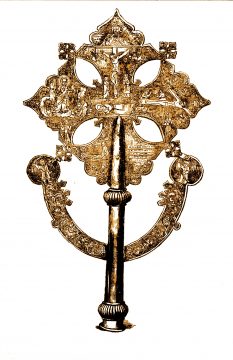Tewodros Ethiopia Restaurant
Location: 10880 Wilshire Blvd. Suite 1101 Los Angeles, CA, 90024

Tewodros II around 1860, |
 Supervising crossing of the Blue Nile |
 Cross of Tewodros II |

The End of King Tewodros |
| Photos: Wikimedia Commons | |||
Tewodros Restaurant in Los Angeles bears the name of Tewodros II, emperor of Ethiopia, known as a unifier, reformer and innovator. Kasa Hailu, the future Emperor Tewodros (or Theodore), was born about 1818. His rise “marked the opening of a new, and crucially important. era of Ethiopian history. Most of his attempted reforms were never achieved, but were nonetheless significant for they seem almost to have charted the course to be taken in the reigns that followed…” (Pankhurst, 143).
“Tewodros II, English Theodore II, original name Kassa, (born c. 1818—died April 13, 1868, Magdela, Ethiopia), emperor of Ethiopia (1855–68) who has been called Ethiopia’s first modern ruler. Not only did he reunify the various Ethiopian kingdoms into one empire, but he also attempted to focus loyalty around the government rather than the Ethiopian church, which he sought to bring under royal control. He worked to abolish the feudal system and create a new nobility of merit, dependent on the ruler alone. Although he failed in these aims, his example was ultimately followed by his successors…” (Encyclopedia Britannica, https://www.britannica.com/) Accessed 8/17/2020.
“Negus Tewodros II began the process of unifying Ethiopia after the century of political disintegration known as the “era of princes,” during which powerful regional warlords contended for power. He was negus or emperor from 1855 to his death. His name is sometimes given in its Western version, Theodore….Tewodros had been educated in monasteries and hoped to reunify Ethiopia to save it from Muslim domination. He began a number of reforms the included abolishing slavery….reducing polygamy, and centralizing the administration….he attempted to undermine the feudal system, centralized taxation, and created a professional army…. His policies caused friction with the clergy, who were able to rally the people around them to erode Tewodros’s base of political support among the peasantry….The death of his wife, whom he truly loved devastated him, and Tewodros began a descent into violence and erratic behavior….regional leaders rebelled until, by 1866, he had lost control of most of the country….he committed suicide with a pistol sent as a gift by Queen Victoria when he first came to power….” (Brockman, 499).
“In April 2018, Ethiopia upped the campaign for its artefacts stolen by British troops to be returned as part of a wider campaign to repatriate important articles of the country’s history sitting in museums overseas. British expeditionary troops ransacked Emperor Tewodros II’s Maqdala fortress in northern Ethiopia using 200 mules and 15 camels (some reports say elephants) to carry the loot of sacred manuscripts and royal gold. The Guardian reported in August 2018 that the Museum had quietly removed from display the emperor’s lock of hair. History has it that Tewodros killed himself at the end of a British invasion in 1868. He opted to die than be taken prisoner, killing himself with a gun gifted to him by Queen Victoria. The invaders reportedly tore off his clothes and cut off his braid which were taken to the UK along with hundreds of other objects that were plundered by the Lt Gen Sir Robert Napier force”. https://www.africanews.com/2019/03/04. Accessed 9/17/2020,
Resources
Brockman, Norbert. “Tewodros.” An African Biographical Dictionary, Grey House, 2006.
Pankhurst, Richard. The Ethiopians, a History. Blackwell Publishing, 2001.
Shaben, Abdur Rahman Alfa. “UK museum to return lock of hair of Ethiopia’s Emperor Tewodros.” AfricaNews.en https://www.africanews.com/ Accessed 9/17/2020.
“Tewodros II.” Encyclopedia of Britannica. https://www.britannica.com/ . Accessed 8/17/2020
“UK Returns Emperor Tewodros’s lock of hair to Ethiopia.” Youtube. March 28, 2019. Accessed 9/16/2020.
